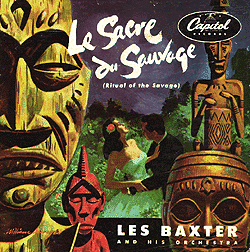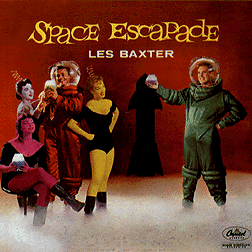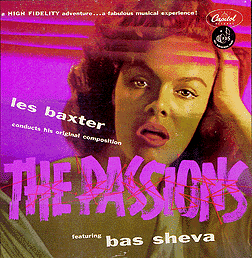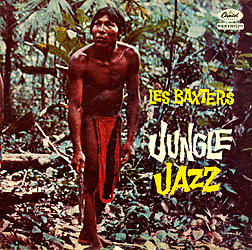(liner notes from the Capitol LP "Les Baxter: The Sounds of Adventure")
 Experimentation and Innovation
Experimentation and InnovationIt has been said that the property of genius is the capacity for effecting changes in set ideas. If this is true, Les Baxter is certainly one of the musical geniuses of the 20th century. Les has always expressed his feeling for his work this way: "Any good music must be an innovation," And Les' entire career has been devoted to his ideal of innovation. However, Les has never sought change for its own sake. He once stated in an interview: "I've never believed in cheapening music by going according to what some people think is public taste. I think that people will respond to quality in the song and in the arrangements... I aim my arrangements at what will fit and colorfully frame the song in the best way possible. And I believe that's what the public will buy. Under my contract with Capitol, I have complete freedom to do just about anything I want in my own way. When I want 30 musicians in the orchestra, I get 30. I don't try to make 15 musicians sound like two each." It is this commitment to only the kind of innovation that will improve upon established forms of music that has sent Les on several trips around the world. Travel - an adventurous search for new sounds, new music - has become a part of Les' life. He studies primitive music constantly - understanding and absorbing the instruments as well as the music and in this way using his "finds" as a part of his natural vocabulary. To point up this insistence on quality, it may be noted that Les Baxter's orchestra is basically made up of "classical" instruments - harp, cello, a large string section, french horns. Only after Les has a valid idea that includes exotic instrumentation is the basic orchestra embellished by the new sounds for which he is so famous. Les Baxter first began to change the musical face and taste of America in 1950 with an album titled "Music Out of the Moon." The album signalled two firsts - it was the first time a long playing record cover had been printed in full color and it was the first modern expression of all the exotic music to follow. At this time also, Les introduced the ethereal sound and feel of outer space with an electronic musical instrument called a theremin.  Actually, the Exotic Movement in music can be traced back to Ravel and "Bolero" - this composition had Parisian audiences in a frenzy in the year 1928. But, "exotica" was not heard in a popular sense until Les Baxter embellished the basic classical ideas with his own innovations. Since "Music Out of the Moon" was released, Les has enjoyed respect and popularity from fellow musicians as well as the public in his continuing success as an innovator and experimenter. Because of his constant contributions to the field of music, no one can forget that Les Baxter originated the Exotic Movement, although there have been imitators. Hit after hit has followed the rise of Les Baxter's fame. "Ritual of the Savage," a tone poem composed and conducted by Les, topped the success of his first album and established his name in the annals of music history permanently. Les' first hand knowledge of native music also has created a demand for his arrangements in creating new dances. When a motion picture entitled "Simba" became popular, the staff of the Arthur Murry Dance Studio asked Les to develop a dance and arrangements for the Afro-rhumba inspired by the film. Contracts for film scores soon followed that request and Les has been using his versatile talents in that capacity ever since. He is now unquestionably established as an industry leader in the field of developing new and different music. Les has won numerous awards for his work - among them are awards for "Lassie," "Flintstones" and other original television scores. Composer - arranger - instrumentalist - orchestra conductor - singer Les Baxter still continues to travel. He spends considerable time in Mexico and South America seeking out century-old manuscripts and storing them away for future use. He is considered an expert on Latin American rhythms and melodies. However, Les does not restrict himself to any one form of music. He is constantly experimenting and searching for new and original ideas to incorporate into his record output. Listen to these twenty milestone selections by Les Baxter and enjoy the past and present knowing that Les has even better musical delicacies waiting in the future. |
 Memories and Milestones
Memories and MilestonesLes Baxter first sat down at the piano when he was five years old. He's been making musical history for himself and musical happiness for others ever since. As a teen-ager, Les entered the Detroit Conservatory of Music and then attended Pepperdine College in Los Angeles, California. After college, Les started doing dance band work (in 1935) and mastered most of the instruments in the orchestra. He was a tenor sax player and arranger for the Freddy Slack orchestra when he first attracted attention during the swing band era. Les then began to work his way up as a free lance arranger - writing for Bob Crosby, Tommy Dorsey and other top bands. For a brief time, Les tried his hand at singing. He joined the Mel Torme group called the "Mel-Tones," but soon shifted back to his first love - composing and conducting. Eventually, Les was called upon to create music for such top radio shows as the Bob Hope show, Ronald Colman's "Halls of Ivy" and the Abbott and Costello Show, among others. Les' radio work led naturally into arranging and a subsequent recording contract with Capitol (1950). This in turn led to his famous arrangements for such stars as Nat King Cole, Margaret Whiting, Yma Sumac, Frank DeVol and others. In fact, it was the young Les Baxter who arranged Nat Cole's million-selling Mona Lisa and Too Young. Also in 1950, Les' first album, "Music Out of the Moon," was released and he began to gain national recognition as an innovator. Les and Harry Revel worked together on this first effort to incorporate exotic musical ideas with modern themes and changed the character of all the current music that followed. From this point on, Les never stopped searching for new ideas, new instruments. Subsequent albums were each more successful than the one before and the name Les Baxter began to appear on top-40 charts with instrumentals such as Quiet Village; Love Is a Fabulous Thing; Autumn Leaves; Fascination; Blue Tango and others.  Les also experimented with rock and roll hits. Pop tunes like Running Bear; Battle of New Orleans; Mister Blue; Mack the Knife and Tom Dooley were turned into sophisticated instrumentals with memorable melodies and earned Les popularity in yet another field. Typical of his never-ending search for new musical expression, Les explained his endeavors this way: "In a sense, a hit belongs to the person who made it popular, but if a tune is good enough to attain tremendous success, then it certainly deserves more than one version, one treatment, one approach. Regardless of who originally made it popular, any hit song becomes a challenge to the ingenuity and imagination of other musicians and performers." The good looking musician has been described as "a cross between John Wayne and Robert Mitchum." Reviewers like Variety describe Les this way: "Les Baxter has been one of the most consistent producers of disk hits among the recording maestros. He has been proficient in a variety of moods and tempos, having started a whole new trend on wax with his quasi-exotic sounds..." Now, you can share in the excitement that Les Baxter still continues to generate in the music industry. You'll recall all the happiest, most thrilling moments in your life with Les Baxter's "variety of moods and tempos." The music of Les Baxter is never sad or gloomy - it is full of the adventure of life, the sounds of exotic lands and the free spirit of life close to nature. Look over the song titles included in this collection of milestone themes - some are from top-40 charts, some mark subtle changes in melody interpretation which affected the outlook of the musical world. Each title describes a mood, paints a musical setting - every song is a thrilling, individual part of the unforgettable experience you are about to hear. Tighten your seat belt and get set to explore the earth's and the mind's farthest reaches - get set to partake of the sounds of yesterday, today and tomorrow - the "Sounds of Adventure!" |
Return to Les Baxter Index
